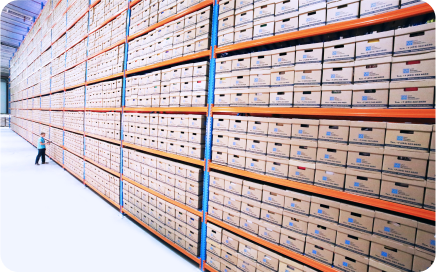Growth Strategy for Wholesale Businesses: How System Choices Make a Difference
By Rackbeat July 4, 2025

When scaling your wholesale business, it’s not just about customers
When planning a growth strategy for your wholesale business, it’s not just about finding new customers or expanding your product range. One crucial — yet often overlooked — factor is the technological foundation.
Do you have the right digital tools to handle more orders, more products, and more complex workflows? Or are your internal processes actually blocking your growth?
In this article, you’ll learn:
Why system selection is central to any growth strategy
What to consider before choosing a system
How modern inventory management systems (WMS) enable scalability
Examples of effective order management and purchasing management that save time and resources
Read on and get a clearer picture of how smart systems can power your growth.
Why choosing the right systems is critical for wholesale growth
As wholesale businesses begin to scale, their operations become more complex. More products, more orders, more suppliers, and rising customer expectations increase the need for efficient processes.
If you’re still working with manual workflows, spreadsheets, or outdated systems, growth can quickly turn from opportunity into operational friction.
Without a solid system foundation, you risk:
Incorrect deliveries: When orders are picked manually without integration to inventory status or scanners, the risk of sending the wrong items or quantities increases — costing time, money, and customer trust.
Lack of visibility into inventory value and location: Without real-time data, it’s difficult to know what’s in stock, where it’s stored, and what it’s worth — making planning, optimization, and fast decision-making harder.
Wasted time on order and purchasing processes: Employees may spend hours updating spreadsheets, copying data between systems, or tracking down manual orders — time that could be spent on value-creating tasks. This limits scalability.
Poor customer experience due to delays and errors: If your systems don’t work together — or are nonexistent — you can’t respond quickly to customer needs. Delivery times slip, information gets lost, and support becomes reactive instead of proactive.
This is where your choice of systems becomes vital. Not as a technical detail, but as a strategic decision that shapes your ability to grow.
What to consider before choosing a system
A new system can be one of the best investments you make — but only if it matches your business needs today and tomorrow. The right WMS or order management system should be more than technically sound — it should fit your business model and workflows.
Key factors to consider:
Scalability: Choose a system that grows with you. Can it handle more products, users, or locations as your business expands?
Ease of use: A system should never be a barrier. It must be intuitive — even for warehouse staff with limited tech experience.
Integrations: Can it integrate with your existing tools — like your accounting software, webshop, or shipping module? Strong integrations save time and reduce manual duplication.
Support and onboarding: A great system comes with great support. Look for vendors that offer thorough onboarding, ongoing support, and a helpful knowledge base.
Data & insights: Ensure you can pull meaningful reports and access real-time insights into inventory, orders, and purchasing. This is essential for decision-making.
Cost and flexibility: Don’t just consider licensing costs. Look at implementation requirements and how easily the setup can be adjusted as your needs evolve.
Inventory management as a growth lever
One of the most vital components in a wholesale growth strategy is inventory management. If you don’t know what you have, where it is, or when to reorder, it becomes nearly impossible to deliver quickly, accurately, and efficiently as your business scales.
A modern Warehouse Management System (WMS) automates and optimizes your warehouse operations. That means no more manual notes, post-its, or color-coded Excel tabs. Instead, you get a clear, real-time overview of your inventory — minimizing errors, wasted time, and double work.
Key WMS features that support growth:
Location management and scanning: Every item has a fixed location, and barcode scanning makes putaway and picking fast and accurate — saving time and reducing errors.
Automatic inventory value updates: The system automatically updates the value of your inventory based on purchases, sales, and movements — so you always know your tied-up capital.
Integration with e-commerce and finance: When your WMS connects with your webshop and accounting system, you eliminate manual entries and data silos. Everything syncs and updates in one place.
Pick and pack flows with barcodes: The system guides staff through optimized picking routes and streamlines packing — resulting in faster processing and fewer mistakes.
Reorder alerts: Based on historical data, you can set minimum stock levels. When these are reached, the system notifies you to reorder — keeping stock healthy and avoiding shortages during peak seasons.
These features don’t just give you control — they give you scalability. You can handle more products, more orders, and more customers without doubling your workforce.
That’s the foundation of sustainable growth.
Efficient order management: From bottleneck to smooth flow
When orders start flooding in, order management is often where the first growing pains emerge. If you don’t know what’s been ordered, what needs picking, or what’s already shipped, you risk delays, errors, and lost revenue.
An order management system ensures a seamless, fast, and transparent order flow — from receipt to dispatch.
Key features in modern order management:
Automatic order import from webshop or ERP: No more copying orders from emails, PDFs, or e-commerce platforms. Everything is synced and ready for processing.
Pick lists with a few clicks: Warehouse staff receive a clear list of what to pick — and where to find it. This reduces mistakes and saves time.
Status overview of all orders: You get full control over pending and shipped orders, delays, and action points — making support easier and reducing miscommunication.
Prioritization of urgent orders: If a customer needs express shipping, you can move the order to the top of the queue and ensure it’s handled first.
With streamlined order flows, you avoid classic growth bottlenecks and can welcome more customers without fear of operational breakdown.
It frees up resources for sales efforts and market expansion.
Purchasing management that keeps your inventory healthy
Purchasing is the backbone of a well-run warehouse — and a key element of any growth strategy. Even the best order system is useless if stock isn’t available when needed.
Without proper structure and oversight, you risk:
Ordering too little and running out during peak seasons
Overordering and tying up capital in dead stock
Missing supplier price hikes and delays
With an optimized purchasing system, you gain full control of your inventory flow and finances — so you can grow with confidence.
Get more practical insights in your inbox
Want more hands-on advice on how to streamline operations and realize your growth strategy?
Sign up for Rackbeat’s monthly newsletter where we share inspiration, cases, and step-by-step guides on:
Inventory management and WMS
Efficient order and purchasing workflows
Digitalization and automation of wholesale operations
New tools and features in Rackbeat
Our newsletter is short, practical, and 100% relevant for professionals working in the ever-evolving world of wholesale logistics.



